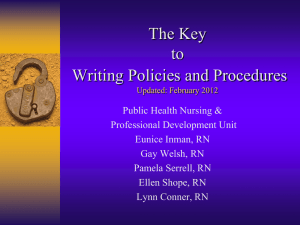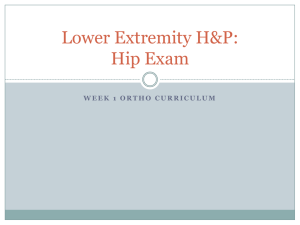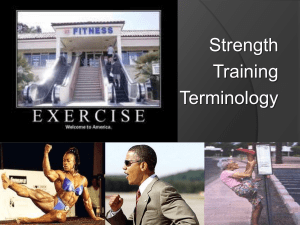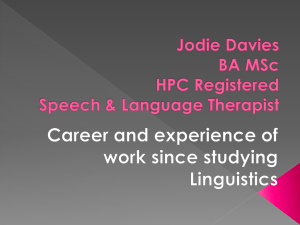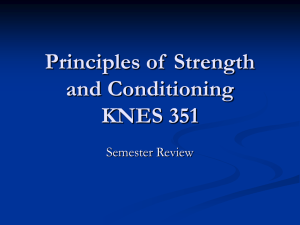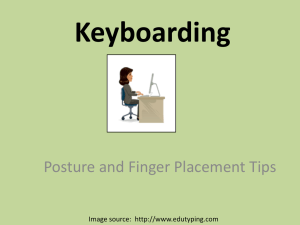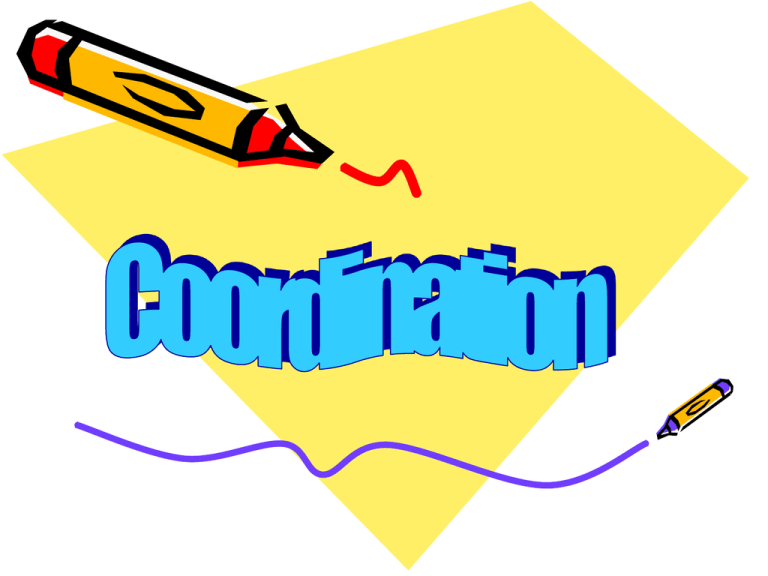
Definition
• Coordination refers to using the right muscles
at the right time with correct intensity,
extensive organization within the central
nervous system is necessary to guide motor
patterns, coordination is the basis of smooth
and efficient movement, which often occurs
automatically.
• Coordination and gross or fine motor skills are
a highly complex aspect of normal motor
function
Factors affecting on coordination:
• Anatomical Factors
– Deformity
– Asymmetry
– Mal posture
Environmental factors:
– Temperature
– Pollution
– Mental and psychological
stress
•
•
•
•
•
•
•
•
•
Pain
Occupation
Life style
Fullness of bladder
Any medication
Repeated pregnancy
Overweight
Age
Type of muscle tone
Consideration before evaluation
A- Outside the clinic
•
•
•
•
•
The presence of parking.
Rail way of stair up & down.
Light at entrance.
Ramp for wheel chair.
If there is lifter or not
•
•
•
•
•
•
•
•
•
•
B- Inside the
Clinic
Clearness of room.
Silence and privacy.
Suitable temperature and light.
Comfortable and relaxed position for the patient.
Adjustable and wide bed.
Explain procedure to patient.
Patient pared skin or with light clothes.
Avoid air draft but maintain good ventilation.
All equipment near the therapist to avoid
interruption.
Evaluation sheet should be present.
Consideration during evaluation
•
•
•
•
•
•
•
•
•
Pain
Sweating
Abnormal heart rate.
Abnormal B.P.
Fever
Fainting.
Hypermobility
Infection
Recent wound and injury
• Avoid position that may exaggerated
muscle tone or patient complication.
• Mental stress.
• All tests done with tolerance of patient
and according the stage of the disease.
• All tests are done within the limit of
pain.
• All tests from zero starting position.
Decision Making
•
•
•
•
•
•
•
Diagnostic interview.
Screening examination
Comprehensive examination.
Special tests.
Long term goals.
Short term goals.
Out come
DIAGNOSTIC INTERVIEW
Personal History:
•Name: To be familiar with the patient
•Age: occurs in people aged 40-50 years
(cerbrovascular stroke)
•Sex: affects men and women equally
•Marital status: Married or single
•Style of life: his habits, activities and if he
living a sedentary life. It assist in providing the
therapist with hint about causes and the
expected prognosis.
• Occupation: Know the patients interests and
hopes
• Habits: Smokers, non smokers, alcohol
drinkers, coffee or tea drinker.
• Weight: obesity increase the difficulty in
performing activities.
• Environmental assessment:
A) Outside door
• - Surrounding home.
• - Stairs (height – width) – (sharp,
smooth) .
• - Entrance .
• - Noisy – pollution.
• - Light at entrance .
• - rails of stairs – height of pavement .
B) Inside door
••••••-
Entrance
Carpets
Type of floor
Furniture
Arrangement
Devices and accessories
Work assessment:
•
•
•
•
Desks.
Height of table and chair.
Width and height of weed chair .
How communicate with people.
BHistory
The importance of History taking:
• To know precautions.
• To know Contra-indications.
• To decide the plane of care/treatment.
•Onset & duration of the disease.
•Site and extent of the lesion: (It affect level of
consciousness and prognosis as the site either Rt
of Lt determine aphasia and speech affection)
•Etiology of the disease.
•Mechanism of the lesion.
•Distribution of paralysis
•Past history: any disease (diabeteshypertension- congenital heart disease), any
previous operation, any previous trauma.
•History of functional A.D.L:
Functional A.D.L is divided into:
•
•
•
•
•
Transfer activities.
Hygiene.
Feeding.
Dressing & undressing.
Gait & ambulation.
Grades (He can do –He can do with minimal
assessment – He can do with maximum
assistant- He can't do)
Family history :
• Any hereditary disease
• Heart diseases
• diabetes
• Neuromuscular diseases due congenital or
genetic factors
• Psychological history: IQ. Level, Cognitive
level, Education level, Affection (emotions –
nervous - fairs), memory, judgment,
depression, how to solve problems.
• Social History: Relationship between patient
and his family members and if they accept or
reject the patient.
Pain History:
• (time of pain – location of pain– If
movement increase or decrease the
pain –– severity of pain – distribution
of pain).
Chief complain
• Difficulties in performing ADL
• Difficulty using arms to dress, feed self,
or perform other tasks
• Urinary incontinence
• Problems with balance
• Decreased sensation, numbness,
tingling on affected side of the body
• Difficulty
speaking
and/or
understanding words
• Difficulty walking
• Depression
or
or
Problem list
•
•
•
•
•
•
•
•
Spasticity .
Muscle weakness
Loss of balance
Loss of coordination
Inability to do functional activities .
Shoulder pain.
Poor hand function.
Respiratory and circulatory problems.
Medical record
– Medications
– Associated handicapped (Vision, Hearing,
Speech)
– Associated reaction.
– Any epileptic fits.
– Incontinence.
– Bed sores.
– Vital signs (B.P.- Heat rate - Temperature)
– X-ray - C.T Scan – M.R.I
Respiratory and circulatory disorders.
– Orofacial dysfunction.
Screening
examination
General observation:
•
•
•
•
•
•
•
Any abnormalities.
Asymmetry.
Distribution & Pattern of paralysis.
Position of head in relation to spasticity.
Position of head in relation to spasticity.
Associated reactions
Imbalance
•
•
•
•
•
•
General heath (out look of face).
Gait & ambulation.
Assistive device.
Way of taking off clothes, way of
getting up & down bed.
Handling of the patient with his
family.
If the family reject or accept the
patient.
Specific observation: with the patient pared
skin. Postural assessment from three views
(lateral – anterior - posterior).
Dermatological system (Scar – operation –
skin disease).
Skeletal system (size of bone – mal alignment
of bone).
Muscular system (atrophy – asymmetry –
hyper trophy).
Join system (edema – swelling).
Breathing pattern.
Palpation
Tender point
Muscle tone
Soft tissue Mobility
Trigger point
Fascial restriction.
Skin texture& temperature.
Comprehensive examination
A- Communication abilities
Vision
Hearing – speech
Way of solving
problem
Judgment
Excitement.
Interest.
By
Pantomine.
Communication
board
B- Mental Status
IQ level
Cognitive level
Education level
C- Arousal status: see the response
of the patient to any movement and
see if the arousal status is low or high.
D- Motor control stages:
a- Mobility stage
Muscle test : Group muscle test (voluntary
muscle test because of spasticity or in pattern
of movement) (gross movement)
Functional ROM test : as feeding – dressing –
undressing – hygiene
Flexibility test (Sound, Affected, and associated
areas
Examples:
long sitting test
Straight leg raising test
Cross sitting test
Standing with forward bending test
Supine and hand stretched overhead
b- Stability stage
Elbow prone test:
importance
Sitting position on a table
Sitting position on an armchair. Then sitting on a
stool: Test patient ability to maintain position
against gravity
Standing position
For head
control
– raise head and sustain position for 30
sec
– If collapse quickly poor
– If can't take or sustain in the position
zero
– If maintain it for 30 sec normal
Sitting position
Sitting on the edge of the bed or table,
test the patient ability to maintain position
against gravity .
Sitting on arm chair then on a stool to test
the patient ability to maintain position
against gravity
Maintain postural alignment
Standing position
Test the patient ability to
maintain position against gravity.
C- Control mobility stage
Change position with maintaining postural control
1) Rocking (body shift): Bushing from different
directions, and from different positions or by lying
on rocking plate .
Done from different positions (Elbow Prone,
quadruped, sitting, kneeling , standing)
Rocking plate from supine - prone and raise from
different direction all testes done 2-3 times before
giving grade.
2) Quadruped position raise one hand, then the
other hand, raise one hand with opposite leg, raise
one leg then another
d- High Skilled activity stage
Swallowing test.
Speech test.
chewing test
Cranial nerve assessment.
Hand function test: a- Volk's man angle
test & b- Metacarpal stability test Hand
Gait and ambulation test: also test
patient ability to get up & down stairs.
E- Voluntary movement
Observe pattern and sequence of movement
from different position
*Supine: do flexion –extension – abduction –
rotation- abdominal exercises
*Sitting: the same movements +trunk rotation +
trunk bending.
*From supine to standing: observe the
sequence of movement: some patients make
side bending + rotation of trunk then stand
while others take the kneeling position then
stand.
F- Functional A.D.L test:
Causes of disability of ADL:
Physical
Affection (emotion psychological)
Mental (IQ level –
Cognitive level education)
Social.
ADL are assessed by:
*Questionnaire or Self
questionnaire
*Multi dimensional function:
it include physical examination
to detect if patient can
do ADL or not.
factors affecting muscle tone
Anxiety
Temperature
Tension
Drugs
Fear
Fullness of bladder
Position of the head
Environmental condition
Vision and hearing
G- Assessment of Muscle Tone
Passive Movement
Ashworth Scale :
To perform this test, the part is moved
through the joint range-of-motion (ROM).
Ashworth Score Criteria:
0 No increase in tone
1 Slight increase in tone, giving a “catch”
when the limb is moved in flexion or
extension
2 More marked increase in tone, but limb
easily flexed
3 Considerable increase in tone; passive
movement difficult
4 Limb rigid in flexion or extension
H- Reflex assessment: Assess superficial
and deep reflexes (tendon reflex,, and
babiniski sign).
I- Postural assessment testes:
Shobber test
Adam's test
Forward bending test.
J- Sensation & perception tests:
Superficial sensation: assessment of pain,
touch, and temperature. Sensation test is
done by pin pricking or test tube.
Deep sensation (Proprioception):
Dynamic sense (sense of movement)
Static sense (sense of position)
Vibration sense
Joint sense:
Rate
of motion
Velocity of motion
Direction of motion
Combined sensation:
stereognosis, two point discrimination, tactile
localization, vibration, paragnosis, and
texture of different materials.
Perception can be evaluated by observation:
patients with perceptual defect have the following
criteria:
Can't follow instruction.
Suffer from confusion
Difficulty in performing A.D.L.
Repeated mistakes
Can't repeated movement
Can't discriminate between body image
and body parts (Summate).
Can't do purposeful movement (Apraxia).
Can't do any construction form.
IV- Special
test
A- Manual Test
Righting reaction
Equilibrium test
Upright position
test
Special tests for coordination
Non-equilibrium coordination
Finger to nose: The shoulder is abducted to 90o with
the elbow extended, the patient is asked to bring tip
of the index finger to the tip of nose.
Finger to therapist finger: the patient and the
therapist site opposite to each other, the therapist
index finger is held in front of the patient, the patient
is asked to touch the tip of the index finger to the
therapist index finger.
Finger to finger: Both shoulders are abducted to
bring both the elbow extended, the patient is asked
to bring both the hand toward the midline and
approximate the index finger from opposing hand .
alternate nose to finger: the patient alternately touch
the tip of the nose and the tip of the therapist's finger
with the index finger.
Equilibrium coordination
tests:
Standing in a normal comfortable posture.
Standing with feet together (narrow base of
support)
Standing with one foot exactly in front of
the other in tendon (toe of one foot
touching heed of opposite foot).
Standing on one foot.
Arm position may be altered in each of the above
postures (that is arm at sides, over head, hands on
waist) .
Displace balance unexpectedly (with carefully
guarding patient).
Standing and then alternate between forward trunk
flexion and return to neutral.
Standing with trunk laterally flexed to each side .
Standing to test the ability to maintain an upright
posture without visual feedback.
Standing in tandem position from eyes open to
eyes closed.
B- Mechanical test
Instrumentation used to assess
coordination
Frenkle's mat
Side turning mat Pivot turning mat
II- Rehabilitation program.
A- Rehabilitation team
Physician – Nurse – Therapist – Social
worker –vocational counselor occupational
therapist – psychiatrist – Dietician –
relatives of patients.
B- Goals
1- Long term goals
Return subject to be independent or
partial independent in ADL and to be
productive member in his society.
2- Short term goals
Enhance functional activities
Improve range of motion
Restore symmetry of both sides
Improve sensory awareness
Normalization of muscle tone
Improve balance
Improve co ordination
Improve gait pattern
Strengthening weakened muscle.
Consideration during rehabilitation :
Avoid exhaustion for the patients
Avoid the bad habits and poor positioning .
Avoid position that may exaggerated muscle
tone or patient complication.
Mental stress.
Check for precautions and contraindication
Rest in between the exercise
There should be goad fixation and stabilization
Rehabilitation should proceed according to
stages of motor learning.
Physical problems of motor control
stage:
Defect in postural tone.
Defect in postural balance.
Defect in functional pattern.
C- Program of treatment
1- Instruction
– Avoid any thing or position that increase spasticity
(excitement, fatigue, pollution, air drafts)
– Suitable clothes not tight or restricting, it should
be made of cotton.
– Ask visitor to seat at affected side to allow weight
bearing and encourage symmetry.
– Avoid over weight (diet that give energy but
reduce carbohydrates intake).
– Wide and stable bed
– Turning every 2 hours to avoid bed
sores.
– Massage back & buttocks
– Rearrangement of furniture
– Head should be deviated to sound side
to ovoid retraction of shoulder also
make elongation of the neck muscles
on the affected side.
– Encourage symmetry: by engagement
of the sound and affected upper limbs.
2- Positioning:
Put the patient in anti-spastic position.
Head deviated to the sound side.
Long pillow under pelvis – thigh to avoid
retraction of pelvis, prevent lateral
rotation, and assist turning. Put small
pillow under the knee.
Pillow under the axilla.
Shoulder in abduction and hand in
functional position.
Use board or wall to put the feet at right
angle to avoid drop foot.
7- Put pillow on his abdomen or in front of
him and he engage his hands on it.
8- Abduct the sound LL apart.
3- General & Local relaxation
Reassure the patient and encourage him
Massage
Hot back
Bio-feed back
Small pillows
Towel or small pillow under the knee
Suitable & comfortable bed
Temperature room, music.
4- Breathing exercise
Diaphragmatic
Costal
Ask patient or his family to open windows
to allow good ventilation.
Proprioceptive training for hemiplegic patient:
A- Mobility stage:
a- Bridging exercise & Single leg bridging
b) Placing exercises:
in placing exercises we can use wall as function tool
proprioception, placing, inhibition, facilitation)
For example:
Raise leg on wall in certain points this position used
in (1) function standing (dorsiflexion -planter
flexion- stretching – proprioception – prevent
deviation). Also it is used as a coordination training
for leg from supine.
Supine and place hand on wall by hand contact on
certain markes on the wall this position used in
prevention of drop wrist as well as coordination.
Proprioceptive neuromuscular facilitation (PNF)
P.NF
is a very important exercise to improve
co ordination between agonistic and
antagonistic muscle groups, and to improve
limb co ordination in general, in the Mobility
stage we can use it in the form of active free
exercise.
Frenkle's exercises:
The
main principles of frenkel's exercises
are the following :
– concentration or attention.
– Precision
- Repetition
frenkel's exercises from
supine
Flex and extend one leg by the heel sliding
down a straight line on the table.
Abduct and adduct hip smoothly with knee
bent and heel on the table.
Abduct and adduct leg with knee and hip
extended by sliding the whole leg on the
table .
Flex and extend hip and knee with heel off
the table .
Flex and extend both legs together with
the heel sliding on the table.
Flex one leg while extending the other.
Flex and extend one leg while taking the
other leg into abduction and adduction.
C- Controlled Mobility stage:
1- Quadruped position: the patient at this stage can
support weight on the affected limb effectively so he
can do reciprocal movement between the affected
upper and sound U.L or the affected and soured L.L
or between upper and lower limb. This improve
coordination between patient extremities and
improve self-esteem.
In the controlled mobility stage we can use be
PNF in the form of active resisted exercises
Frankle's Exercises for the legs in
sitting :
One leg is stretched to slide the heel to a
position indicated by a mark on the floor.
The alternate leg is lifted to place the
heel on the marked point.
From stride sitting posture patient is
asked to stand and them site.
Rise and site with knees together.
Frenkle's Exercises for the legs in
standing:
In stride standing weight is transferred from
one foot to other.
Place foot forward and backward on straight
line.
D-
Highly
skilled
stage:
activity
Walks along a widening s teps .
Walk between two parallel lines.
Walks sideways by placing feet on the
marked point.
Walk and turn around.
Walk and change direction to avoid
obstacles.
Sideways walking
Pivot turning
From sitting position : we can improve
coordination (eye – hand coordination) by
using puzzles and big board.
also we can use roller and move it using both
hands to improve co ordination between both
hands
Squatter and trolley for the leg and move the
foot forward, backward and sideward.
• use roller and move it using his
both hands
Home program and advices
1- Regular maintaining antispastic position.
2- Always use affected side together with the
sound side to decrease the associated
reactions.
3- Patient instructed to do movements in
functional pattern.
4- Patient trained on defensive mechanism.

